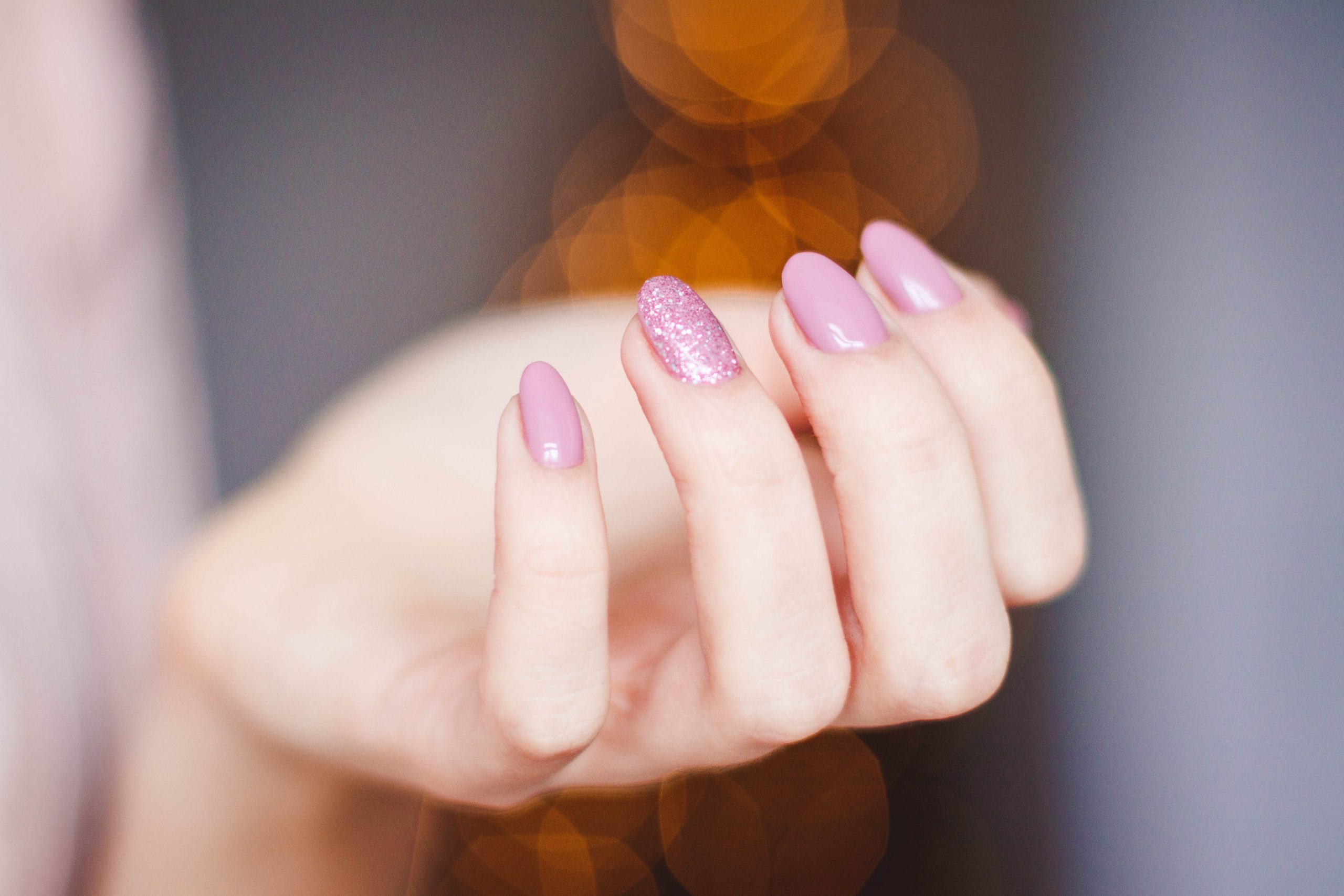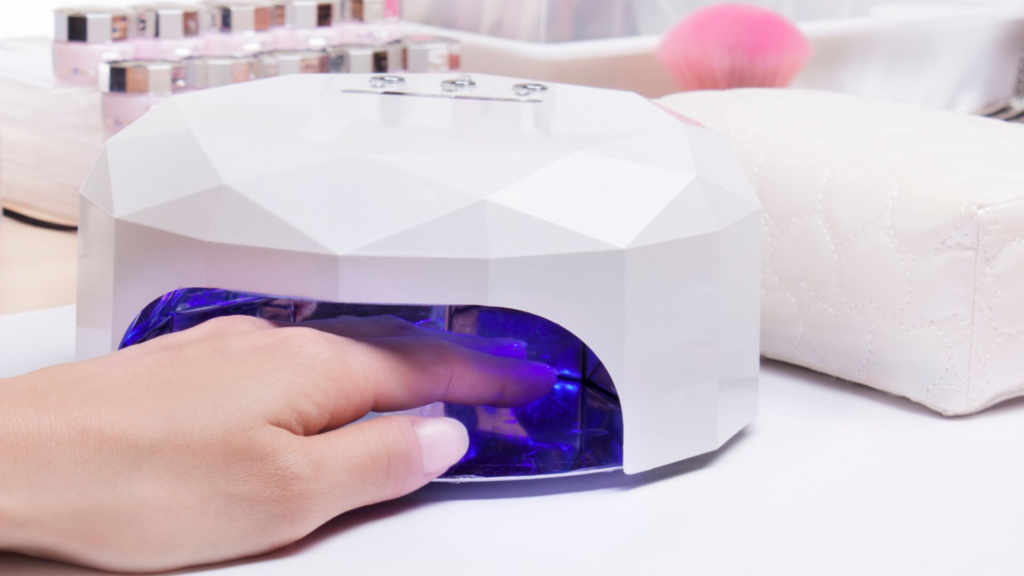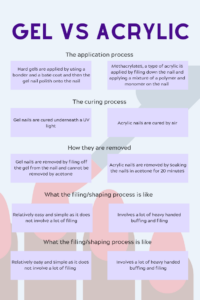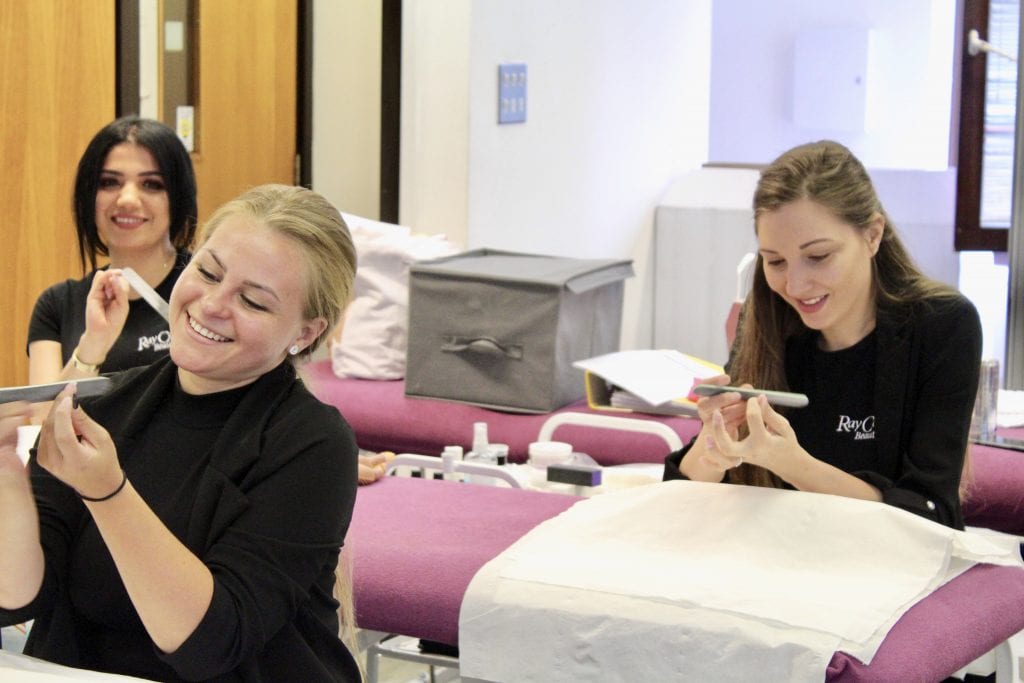
Acrylic and Gel nails are the flawless solution to chip-free, freshly polished nails that last for weeks on weeks. In today’s blog post, we will be explaining everything you need to know about gel and acrylic nails and how the two types of nail polish treatments differ from one another.
What are Gel Nails?
Gel nails are a type of acrylic nails, they have a more glossy appearance than acrylic nails which tend to be sturdier. Acrylic nail manicures tend to cater to those who want to go for a more creative and dramatic look by enhancing their nails with artificial nails.
What are Acrylic Nails?
Acrylic nails are made with a powder that is dipped in solvent which is used to lengthen the nail and provide a stronger top layer over your natural nails.
The main difference between gel and acrylic nails is that the gel nails are cured underneath a UV light whereas acrylic nails are cured by air. The filing process for gel nails is relatively easy and simple. The filing process for acrylic nails involves a lot of heavy handed buffing and filing.
Read More – Halloween Nail Design Ideas
The application process for Gel and Acrylic nails
Acrylic Nails

The application of acrylic nails involves filing down your natural nail to create a rough surface to place the glue on. When this step has been completed, the acrylic powder and liquid are combined to create a mixture to create a mold to glue onto your nails.
The artificial nail mold is then shaped and buffed to make your nails appear longer to the custom length and shape you desire.
Acrylics come in the form of a powder called a polymer and liquid form which is known as a monomer. They are kept in two separate containers and when they are mixed together it becomes acrylic and looks like a bead. The type of acrylic that acrylic nails contain is called methacrylates.
The interesting fact and most noticeable difference when it comes to acrylic nails are that they cure whilst applying them onto the nail. Acrylic nails cure when coming into contact with air, which is why they have to be applied quickly as gel nails are cured under a UV light. Also, gel nails are self-reliant and don’t need to be mixed with polymer powders.
The removal process of acrylic nails consists of soaking in acetone for 20 minutes.
Gel Nails

Gel nails were introduced to the beauty market back in the 1980s as traditional gels which were hard gels. As time went on, new variations were introduced that were weakened formulas of hard gels known as soft gels and gel polishes.
Hard gels are for those who are looking to extend the length of their nails or keep their long, natural nails. They cannot be soaked off and are cured to a non-porous finish (this means that acetone and other solvents won’t get into them which in turn makes them last longer than regular nail polish).
During application, hard gels use a bonder that has to be put down (e.g, a protein bond) and a base coat that is applied before the hard gel. Next, a builder which builds the artificial nail and lastly a clear top coat is applied to give a glossy finish to end on. The curing process consists of placing the polished nails underneath a UV lamp for a few minutes. The removal process requires the hard gel being filed off as it cannot be soaked off.
Soft gels and gel polishes have a much more liquid consistency than hard gels. They are ideal if you are wanting to add strength to weaker nails that are shorter in length. They are considered to be a highly popular product out on the market today and there are some gel nail polishes out on the market that include a base, colour and topcoat in one. However, they tend to be difficult to soak off during removal and you don’t have the option of placing a protective base coat over the natural nail before application. A lot of them also tend to be hybrids so they’re a mixture gel polish and regular nail polish which means it’s susceptible to drying out if they were left open and exposed to air.
One of these hybrids is a popular brand on the market which is known as Shellac. It is a semi-permanent polish that is a popular type of manicure offered by many nail salons. Shellac manicures are where Shellac is painted on natural nails after performing dry cuticle work and shaping the nail neatly.
On our Nail Technician courses at Ray Cochrane we teach our students all about hard gels. We take them through the application process, tips, natural overlay and finish.

How you can create your own incredible nail looks

Instead of paying copious amounts to get your nails done or if you are a total nail addict and want to take your hobby to the next level and get paid to do them for a living, why don’t you learn how to become a nail technician with us? At Ray Cochrane Beauty Academy, we offer the complete package course for those looking to enhance their nail artistry skills.
We first opened our doors to our beauty academy all the way back in 1954 we were the first to introduce CIDESCO to the UK, it’s the world’s most prestigious qualification in beauty filed to the UK by our founder Ms Ray Cochrane in 1961. We are an intentionally small and selective school and can, therefore, offer a level of tuition and support which larger institutions cannot.
Our highly sought after Nail Technician Course is the perfect launchpad to become a qualified nail technician in the UK to get you on your way to becoming a certified nail technician which can lead you to a number of different avenues within the nail industry from being able to successfully set up your own freelance nail business to being able to rent a station in a beauty salon to carry out nail treatments.
The Nail Technician course runs over 10 weeks and goes through the steps on nail artistry and the anatomical elements of nail care, such as:
- Health & Safety considerations & regulations
- Hygiene & preparing the client, treatment room & trolley
- Anatomy & physiology: structure of the skin, the structure of the nail
- Nail diseases & disorders
- Client consultations / contra-indications
- Manicure & Pedicure
- UV Gel Nail Extension
- Acrylic Nails Extension
- Nail Art
- Electric Files
- Nail Wraps
Throughout your time with us, we will take you through all the aspects of becoming a successful nail tech. After each module, students will then go away to complete a programme of home theory study with the help of our learner pack.
There will be practical and written assignments which can be completed in the students own time before attending any assessments.
There are a range of benefits you receive when studying this course. These include:
- No experience is necessary to study with us – You don’t need to have any previous nail qualifications to enrol onto the course. We take on complete beginners and provide them with all the education they need.
- Central London location – Our nail technician course is based in our Canary Wharf and Baker Street branches which are served by many great transportation links making it easily accessible.
- Small group training – We specialise in teaching small-sized classes as this is the best way for us to give each student the attention and care they need whilst studying with us.
- Support in your career – Are you thinking of being your own boss? We can help you out with that! We highly encourage and support those who want to take the entrepreneurial route, as well as those who would like to work in a nail salon.
- Access to live job vacancies – We continually offer our students access to potential work they can take up with a range of companies who reach out to us that are highly respected and acknowledged within the industry.
Gel vs Acrylic Nails – Commonly asked questions
1. Acrylic vs gel nails: Which lasts longer?
Both hard gel nails and acrylic nails last 2-3 weeks.
2. How are acrylic and gel nails cured?
Acrylic nails are cured by air and gel nails have to be placed under a UV light.
3. How safe are gel vs. acrylic nails?
Acrylic nails can pose at risk for infection if incorrectly applied, this can lead to damage to the natural nail bed. If you file away too much of the cuticle, this will lead to an increase of a bacterial infection because your cuticles are what protects your nails from bacteria.
4. Do gel nails look more natural than acrylic?
Gel nails often appear more natural than acrylic due to their thinner application and glossy finish.
5. Can I get gel or acrylic nails if my natural nails are weak and brittle?
Yes, you can get gel or acrylic nails even if your natural nails are weak, but it’s advisable to consult a nail technician.
6. Can I use regular nail polish on top of gel nails or acrylic nails?
Regular nail polish can be applied on top of gel nails, but not on acrylic nails due to their harder surface.
7. What is the average drying time for gel nails versus acrylic nails?
Gel nails dry faster under UV/LED light, typically in 1-2 minutes, while acrylic nails air dry in about 15-30 minutes.
Are you ready to get on your way to becoming a nail technician and create stunning nail designs for clients everyday? Give us a ring on 0203 856 8886 or email us at email@raycochrane.co.uk
